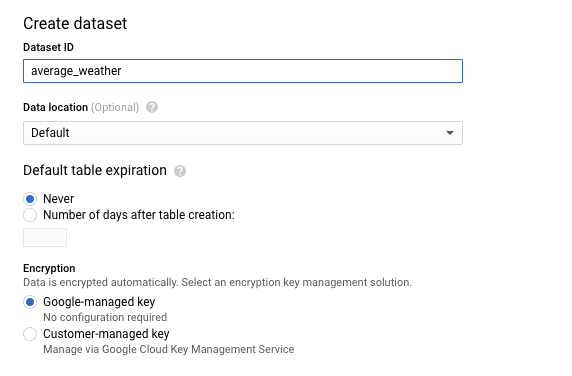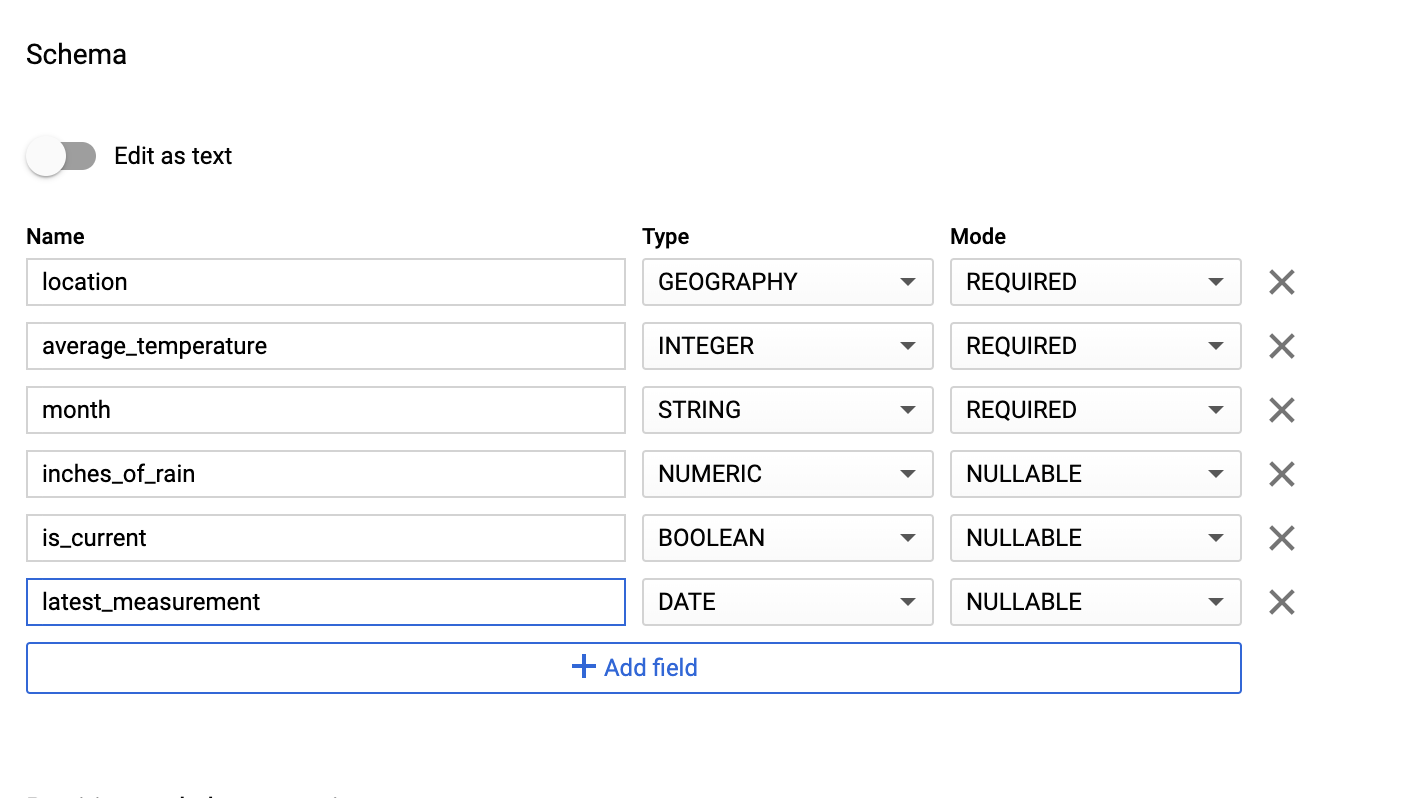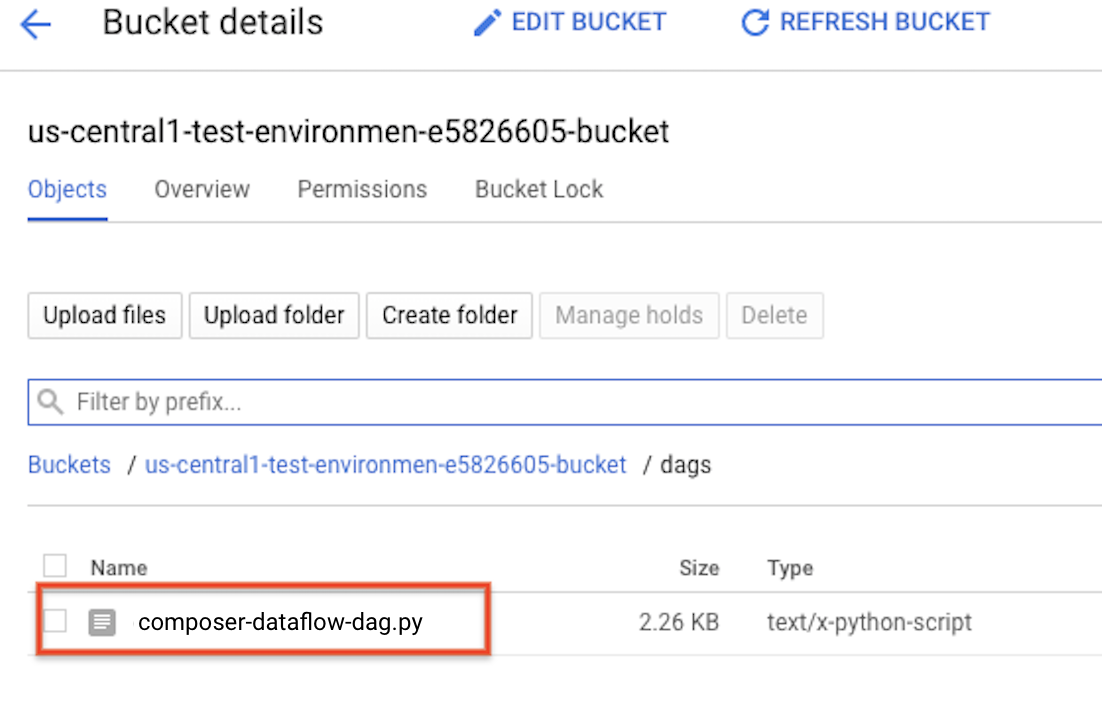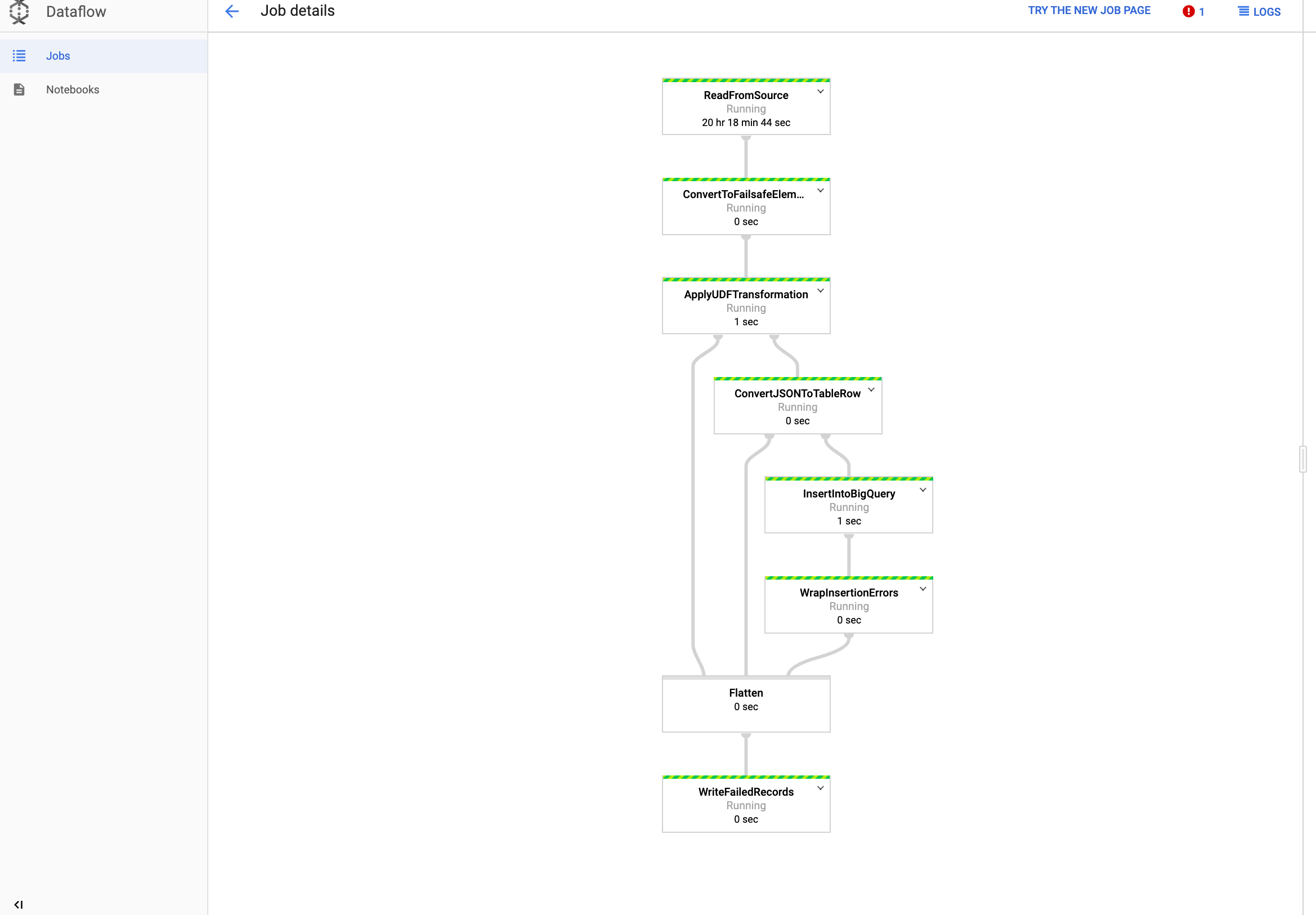Cloud Composer 3 | Cloud Composer 2 | Cloud Composer 1
Questa pagina descrive come utilizzare DataflowTemplateOperator per avviare le pipeline di Dataflow da Cloud Composer.
La pipeline Testo di Cloud Storage in BigQuery è una pipeline batch che ti consente di caricare i file di testo archiviati in Cloud Storage, trasformarli utilizzando una funzione JavaScript definita dall'utente (UDF) fornita e recapitare i risultati in BigQuery.

Panoramica
Prima di avviare il flusso di lavoro, devi creare le seguenti entità:
Una tabella BigQuery vuota di un set di dati vuoto che conterrà le seguenti colonne di informazioni:
location,average_temperature,monthe, facoltativamente,inches_of_rain,is_currentelatest_measurement.Un file JSON che normalizza i dati del file
.txtnel formato corretto per lo schema della tabella BigQuery. L'oggetto JSON avrà un array diBigQuery Schema, dove ogni oggetto conterrà il nome di una colonna, il tipo di input e se si tratta o meno di un campo obbligatorio.Un file
.txtdi input che conterrà i dati che verranno caricati in batch nella tabella BigQuery.Una funzione definita dall'utente scritta in JavaScript che trasformerà ogni riga del file
.txtnelle variabili pertinenti per la nostra tabella.Un file DAG di Airflow che indirizzi alla posizione di questi file.
Poi caricherai il file
.txt, il file UDF.jse il file schema.jsonin un bucket Cloud Storage. Caricherai inoltre il DAG nel tuo ambiente Cloud Composer.Dopo aver caricato il DAG, Airflow eseguirà un'attività da questo. Questa attività avvia una pipeline Dataflow che applica la funzione definita dall'utente al file
.txte lo formatta in base allo schema JSON.Infine, i dati verranno caricati nella tabella BigQuery che hai creato in precedenza.
Prima di iniziare
- Questa guida richiede familiarità con JavaScript per scrivere la funzione definita dall'utente.
- Questa guida presuppone che tu abbia già un ambiente Cloud Composer. Per crearne uno, consulta Creare un ambiente. Puoi utilizzare qualsiasi versione di Cloud Composer con questa guida.
-
Enable the Cloud Composer, Dataflow, Cloud Storage, BigQuery APIs.
Roles required to enable APIs
To enable APIs, you need the Service Usage Admin IAM role (
roles/serviceusage.serviceUsageAdmin), which contains theserviceusage.services.enablepermission. Learn how to grant roles.
Creare una tabella BigQuery vuota con una definizione di schema
Crea una tabella BigQuery con una definizione di schema. Utilizzerai questa definizione di schema più avanti in questa guida. Questa tabella BigQuery conterrà i risultati del caricamento collettivo.
Per creare una tabella vuota con una definizione dello schema:
Console
Nella console Google Cloud, vai alla pagina BigQuery:
Nel riquadro di navigazione, nella sezione Risorse, espandi il progetto.
Nel riquadro dei dettagli, fai clic su Crea set di dati.

Nella pagina Crea set di dati, nella sezione ID set di dati, assegna un nome al set di dati
average_weather. Lascia invariato lo stato predefinito di tutti gli altri campi.
Fai clic su Crea set di dati.
Torna al riquadro di navigazione, nella sezione Risorse, espandi il progetto. Quindi, fai clic sul set di dati
average_weather.Nel riquadro dei dettagli, fai clic su Crea tabella.

Nella sezione Origine della pagina Crea tabella, seleziona Tabella vuota.
Nella sezione Destinazione della pagina Crea tabella:
Per Nome set di dati, scegli il set di dati
average_weather.
Nel campo Nome tabella, inserisci il nome
average_weather.Verifica che Tipo di tabella sia impostato su Tabella nativa.
Nella sezione Schema, inserisci la definizione dello schema. Puoi utilizzare uno dei seguenti approcci:
Inserisci le informazioni dello schema manualmente attivando Modifica come testo e inserendo lo schema della tabella come array JSON. Digita i seguenti campi:
[ { "name": "location", "type": "GEOGRAPHY", "mode": "REQUIRED" }, { "name": "average_temperature", "type": "INTEGER", "mode": "REQUIRED" }, { "name": "month", "type": "STRING", "mode": "REQUIRED" }, { "name": "inches_of_rain", "type": "NUMERIC" }, { "name": "is_current", "type": "BOOLEAN" }, { "name": "latest_measurement", "type": "DATE" } ]Utilizza Aggiungi campo per inserire manualmente lo schema:

Per Impostazioni di partizionamento e clustering, lascia il valore predefinito
No partitioning.Nella sezione Opzioni avanzate, per Crittografia, lascia il valore predefinito
Google-owned and managed key.Fai clic su Crea tabella.
bq
Utilizza il comando bq mk per creare un set di dati vuoto e una tabella in questo set di dati.
Esegui il seguente comando per creare un set di dati sul clima globale medio:
bq --location=LOCATION mk \
--dataset PROJECT_ID:average_weather
Sostituisci quanto segue:
LOCATION: la regione in cui si trova l'ambiente.PROJECT_ID: l'ID progetto.
Esegui il comando seguente per creare una tabella vuota in questo set di dati con la definizione dello schema:
bq mk --table \
PROJECT_ID:average_weather.average_weather \
location:GEOGRAPHY,average_temperature:INTEGER,month:STRING,inches_of_rain:NUMERIC,is_current:BOOLEAN,latest_measurement:DATE
Una volta creata la tabella, puoi aggiornare la scadenza, la descrizione e le etichette della tabella. Puoi anche modificare la definizione dello schema.
Python
Salva questo codice come
dataflowtemplateoperator_create_dataset_and_table_helper.py
e aggiorna le variabili in modo che riflettano il progetto e la località, quindi
eseguilo con il seguente comando:
python dataflowtemplateoperator_create_dataset_and_table_helper.py
Python
Per autenticarti a Cloud Composer, configura le credenziali predefinite dell'applicazione. Per ulteriori informazioni, consulta Configurare l'autenticazione per un ambiente di sviluppo locale.
Crea un bucket Cloud Storage
Crea un bucket per contenere tutti i file necessari per il flusso di lavoro. Il DAG che creerai più avanti in questa guida farà riferimento ai file che carichi in questo bucket di archiviazione. Per creare un nuovo bucket di archiviazione:
Console
Apri Cloud Storage nella console Google Cloud.
Fai clic su Crea bucket per aprire il modulo di creazione del bucket.
Inserisci le informazioni sul bucket e fai clic su Continua per completare ogni passaggio:
Specifica un nome univoco a livello globale per il bucket. Questa guida utilizza
bucketNamecome esempio.Seleziona Regione per il tipo di località. Quindi, seleziona una posizione in cui verranno archiviati i dati del bucket.
Seleziona Standard come classe di archiviazione predefinita per i tuoi dati.
Seleziona il controllo dell'accesso Uniforme per accedere ai tuoi oggetti.
Fai clic su Fine.
gcloud
Utilizza il comando gcloud storage buckets create:
gcloud storage buckets create gs://bucketName/
Sostituisci quanto segue:
bucketName: il nome del bucket che hai creato in precedenza in questa guida.
Esempi di codice
C#
Per autenticarti a Cloud Composer, configura le credenziali predefinite dell'applicazione. Per ulteriori informazioni, consulta Configurare l'autenticazione per un ambiente di sviluppo locale.
Go
Per autenticarti a Cloud Composer, configura le credenziali predefinite dell'applicazione. Per ulteriori informazioni, consulta Configurare l'autenticazione per un ambiente di sviluppo locale.
Java
Per autenticarti a Cloud Composer, configura le credenziali predefinite dell'applicazione. Per ulteriori informazioni, consulta Configurare l'autenticazione per un ambiente di sviluppo locale.
Python
Per autenticarti a Cloud Composer, configura le credenziali predefinite dell'applicazione. Per ulteriori informazioni, consulta Configurare l'autenticazione per un ambiente di sviluppo locale.
Ruby
Per autenticarti a Cloud Composer, configura le credenziali predefinite dell'applicazione. Per ulteriori informazioni, consulta Configurare l'autenticazione per un ambiente di sviluppo locale.
Crea uno schema BigQuery in formato JSON per la tabella di output
Crea un file di schema BigQuery in formato JSON che corrisponda alla tabella di output creata in precedenza. Tieni presente che i nomi, i tipi e le modalità dei campi devono corrispondere a quelli definiti in precedenza nello schema della tabella BigQuery. Questo file normalizzerà i dati del file .txt in un formato compatibile con lo schema BigQuery. Assegna un nome al file
jsonSchema.json.
{
"BigQuery Schema": [
{
"name": "location",
"type": "GEOGRAPHY",
"mode": "REQUIRED"
},
{
"name": "average_temperature",
"type": "INTEGER",
"mode": "REQUIRED"
},
{
"name": "month",
"type": "STRING",
"mode": "REQUIRED"
},
{
"name": "inches_of_rain",
"type": "NUMERIC"
},
{
"name": "is_current",
"type": "BOOLEAN"
},
{
"name": "latest_measurement",
"type": "DATE"
}]
}
Creare un file JavaScript per formattare i dati
In questo file, dovrai definire la funzione UDF (User Defined Function) che fornisce la logica per trasformare le righe di testo nel file di input. Tieni presente che questa funzione prende ogni riga di testo nel file di input come proprio argomento, pertanto verrà eseguita una volta per ogni riga del file di input. Assegna un nome al file
transformCSVtoJSON.js.
Crea il file di input
Questo file conterrà le informazioni che vuoi caricare nella tabella BigQuery. Copia questo file localmente e assegnagli il nome
inputFile.txt.
POINT(40.7128 74.006),45,'July',null,true,2020-02-16
POINT(41.8781 87.6298),23,'October',13,false,2015-02-13
POINT(48.8566 2.3522),80,'December',null,true,null
POINT(6.5244 3.3792),15,'March',14,true,null
Carica i file nel bucket
Carica i seguenti file nel bucket Cloud Storage che hai creato in precedenza:
- Schema BigQuery in formato JSON (
.json) - Funzione definita dall'utente JavaScript (
transformCSVtoJSON.js) Il file di input del testo che vuoi elaborare (
.txt)
Console
- Nella console Google Cloud, vai alla pagina Bucket in Cloud Storage.
Nell'elenco dei bucket, fai clic sul bucket.
Nella scheda Oggetti del bucket, esegui una delle seguenti operazioni:
Trascina i file che ti interessano dal desktop o dal gestore file al riquadro principale della console Google Cloud.
Fai clic sul pulsante Carica file, seleziona i file da caricare nella finestra di dialogo visualizzata e fai clic su Apri.
gcloud
Esegui il comando gcloud storage cp:
gcloud storage cp OBJECT_LOCATION gs://bucketName
Sostituisci quanto segue:
bucketName: il nome del bucket che hai creato in precedenza in questa guida.OBJECT_LOCATION: il percorso locale dell'oggetto. Ad esempio,Desktop/transformCSVtoJSON.js.
Esempi di codice
Python
Per autenticarti a Cloud Composer, configura le credenziali predefinite dell'applicazione. Per ulteriori informazioni, consulta Configurare l'autenticazione per un ambiente di sviluppo locale.
Ruby
Per autenticarti a Cloud Composer, configura le credenziali predefinite dell'applicazione. Per ulteriori informazioni, consulta Configurare l'autenticazione per un ambiente di sviluppo locale.
Configura DataflowTemplateOperator
Prima di eseguire il DAG, imposta le seguenti variabili Airflow.
| Variabile Airflow | Valore |
|---|---|
project_id
|
L'ID progetto |
gce_zone
|
Zona Compute Engine in cui deve essere creato il cluster Dataflow |
bucket_path
|
La posizione del bucket Cloud Storage che hai creato in precedenza |
Ora farai riferimento ai file che hai creato in precedenza per creare un DAG che avvia il flusso di lavoro di Dataflow. Copia questo DAG e salvalo localmente come composer-dataflow-dag.py.
Airflow 2
Airflow 1
Carica il DAG in Cloud Storage
Carica il DAG nella cartella /dags nel
bucket dell'ambiente. Una volta completato il caricamento, puoi visualizzarlo facendo clic sul link Cartella DAG nella pagina degli ambienti Cloud Composer.

Visualizza lo stato dell'attività
- Vai all'interfaccia web di Airflow.
- Nella pagina DAG, fai clic sul nome del DAG (ad es.
composerDataflowDAG). - Nella pagina Dettagli DAG, fai clic su Visualizzazione grafico.
Controlla lo stato:
Failed: l'attività è racchiusa in un riquadro rosso. Puoi anche tenere premuto il cursore sopra l'attività e cercare Stato: non riuscito.Success: l'attività è racchiusa in un riquadro verde. Puoi anche tenere premuto il cursore sull'attività e controllare se è visualizzato lo stato State: Success.
Dopo alcuni minuti, puoi controllare i risultati in Dataflow e BigQuery.
Visualizzare il job in Dataflow
Nella console Google Cloud, vai alla pagina Dataflow.
Il tuo job si chiama
dataflow_operator_transform_csv_to_bqcon un ID univoco associato alla fine del nome con un trattino, come segue:
Fai clic sul nome per visualizzare i dettagli del job.

Visualizza i risultati in BigQuery
Nella console Google Cloud, vai alla pagina BigQuery.
Puoi inviare query utilizzando SQL standard. Utilizza la seguente query per visualizzare le righe aggiunte alla tabella:
SELECT * FROM projectId.average_weather.average_weather

